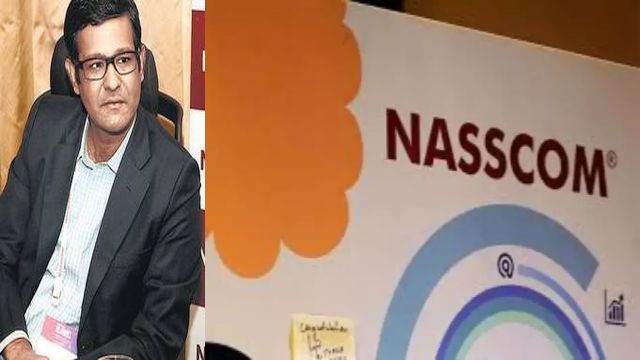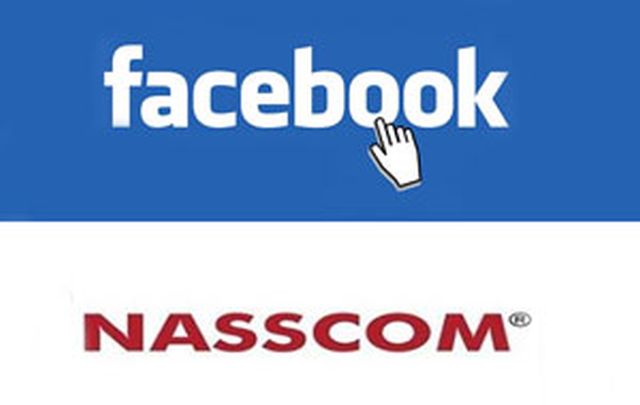
by admin | May 25, 2021 | Corporate, Corporate Buzz, Interviews, Markets, Technology
 By Bhavana Akella,
By Bhavana Akella,
Bengaluru : As the demand for disruptive technologies like Artificial Intelligence (AI) and Data Analytics grows, shortage of a skilled IT workforce to run them is posing a challenge to the stake-holders, Nasscom, the industry’s apex body, has said.
“There is an urgent need to re-skill about 50 per cent of India’s IT workforce, as demand for it in new technologies remains unmet,” Nasscom’s IT-ITeS (IT enabled Services) Sector Skills Council chief executive Amit Aggarwal told IANS here.
The National Association of Software and Services Companies (Nasscom) is the apex body representing the country’s IT and business process management (BPM) industry.
The demand-supply gap for skills affected the industry’s performance in 2018, due to shortage of 140,000 skilled techies for 500,000 jobs in the industry across verticals.
“Going forward, the industry will face a shortage of 230,000 skilled techies as jobs in AI and Big Data are estimated to be 780,000 by 2021,” Aggarwal pointed out.
In a report titled ‘The Future of Jobs 2018’, the World Economic Forum (WEF) said around 54 per cent of the global workforce had to be re-skilled or up-skilled to work in disruptive and digital technologies spawning the virtual world.
AI, big data analytics and cloud computing will dominate businesses across verticals till 2022, changing job profiles for geeks, while legacy jobs will vanish, the report said.
Admitting that the multi-billion-dollar IT industry had a vital role in creating jobs as well as in churning out the required skilled workforce, Aggarwal said India was well-positioned to bridge the demand-supply gap, as it had a wealth of talent in science, technology, engineering and mathematics (STEM).
“Adoption of new technologies will change the profile of present jobs, which will evolve into higher domains with more automation that pose challenges to the $167 billion Indian IT services industry,” Aggarwal asserted.
One of the challenges is to identify the nature of jobs in future and re-skill the present workforce for the transition to digital work.
As the industry adopts to new technologies spanning AI, machine learning (ML), data analytics, automation, robotics, blockchain, cloud and the Internet of Things (IoT), companies with legacy systems and obsolete workforce face challenges to survive the disruption.
The apex body’s ‘Future Skills’ digital platform, unveiled by Prime Minister Narendra Modi in February 2018, has identified 10 key technologies in which maximum job creation can occur in the IT and IT-enabled Services sectors.
The digital portal makes resources available for techies to hone their skills. According to the platform, technologies which will create new jobs include AI, cyber security, IoT, virtual reality, robotic process automation, big data analytics, blockchain, three-dimension (3-D) printing, cloud computing and social and mobile.
“About 70 job roles were identified across 10 technologies that will require the future workforce to have about 150 varied skills,” Aggarwal said.
Besides training the workforce in new skills, there is a need to include evolving technologies in the curriculum for the students, Aggarwal noted.
The industry body has tied up with state-run premier institutions like the Indian Institute of Technology-Madras to hone the skills of students entering the workforce in the IT sector.
“The industry is spending about Rs 10,000-crore for re-skilling and human resource development,” Aggarwal pointed out. “Making the system agile and flexible can help in preparing the IT workforce for the future,” Aggarwal reiterated.
(Bhavana Akella can be contacted at bhavana.a@ians.in )
—IANS

by admin | May 25, 2021 | Business, Entrepreneurship, Large Enterprise, SMEs, Startup Basics
 By Bhavana Akella,
By Bhavana Akella,
Bengaluru : India witnessed a dramatic rise of eight unicorns in 2018 from among the start-ups across verticals as against a mere nine in six years from 2011 till 2017, according to IT industry apex body Nasscom.
The start-ups joining the select club for their valuation over $1 billion (Rs 7,000 crore or more) are Oyo Rooms (hospitality), Zomato and Swiggy (food delivery), Udaan (retailer marketplace), Byju’s, (edu-tech), Paytm Mall (e-tail), Freshworks (software programmer) and Policybazaar (digital insurance).
“As the start-ups that became unicorns this year are based on subscription and Software as a Service (SaaS) models, they took a few years to mature,” Nasscom Vice President (Industry Initiatives) K.S. Viswanathan told IANS.
The focus of these start-ups to acquire customers globally made them unicorns from India, he asserted.
According to the National Association of Software and Services Companies’ (Nasscom) October report on “Indian Start-up Ecosystem: Approaching Escape Velocity”, about 1,200 start-ups were added till September.
“The Indian ecosystem is adding about 1,300 start-ups every year but also seeing the demise of at least 300 of them from previous years,” Viswanathan admitted, assessing their survival rate at three to five years.
With the addition of the start-ups, about 40,000 jobs were created during the year, taking their total in the ecosystem of 7,200-7,500 firms to 1.6-1.7 lakh.
The world’s largest retail giant, Walmart, in May bought 77 per cent equity stake in the country’s earliest e-tailer unicorn, Flipkart, for a whopping $16 billion in one of the largest e-commerce deals globally.
“The Flipkart acquisition by Walmart was a shot in the arm for the country’s start-up sector,” Viswanathan said.
The investment in the native start-ups rose by a phenomenal 108 per cent annually to $4.2 billion in nine months (January-September) from $2 billion in the same period of 2017, the Nasscom report said.
By year-end, Swiggy and Byju’s raised hefty venture funds of $1 billion and $540 million (Rs 3,866-crore), respectively, indicating that global institutional and angel investors are betting on Indian unicorns.
According to the New York-based market intelligence platform CB Insights, about 60 per cent of the funds raised by Indian start-ups were invested in unicorns.
Adoption of disruptive technologies across verticals spanning education, food, health, hospitality and transportation has been driving growth of Indian start-ups.
For instance, the four-year-old Swiggy, which has raised $1.26 billion so far, has been investing in its digital platform and delivery fleet.
“One of the reasons for our success is our industry-changing innovations and focus on delivering the best consumer experience. Our delivery-only kitchens have also enabled our entry into 42 cities across the country in last six months,” a Swiggy spokesperson told IANS.
During the year, Oyo and Ola also began expanding aggressively in the international markets.
Gurugram-based Oyo said it invested on its technological prowess, sustaining demand generation across online and offline channels and identification and upgradation of properties within a short time to spur growth.
The company raised $1 billion from SoftBank and other investors to become a unicorn.
“We saw many firsts and celebrated key milestones this year. We entered three international markets — the UAE, Britain and Indonesia,” Oyo founder and chief executive Ritesh Agarwal told IANS.
Competing against the American ride-hailing firm Uber, city-based Ola forayed into international markets starting in Australia and entered Britain and New Zealand.
Food delivery and restaurant search platform Zomato, which raised over $600 million since its founding in 2008 in Gurugram in Haryana, entered the unicorn club this year, according to Nasscom data.
Zomato has been expanding overseas since 2012 and operates in 24 countries, including Australia, Britain, Canada and the US.
The start-up ecosystem and its enablers, including stakeholders and policy regulations, play a key role in the growth of any firm, said Zomato’s global head of classifieds business Oytun Calapover.
“Zomato is a great example of a homegrown start-up, which has been able to build equity not just in the home country, but overseas as well. This has been made possible by factors like government regulations and stakeholders,” Calapover told IANS.
The central government’s policies like Start-up India, Digital India and 100 per cent foreign direct investment (FDI) in e-commerce have helped the country become a “land of unicorns”, Calapover added.
Though the start-ups had a satisfactory year, the number of women leading some of them remained low. Of the total start-up founders, 11 per cent were women in 2017-18, up a mere three percentage points from eight per cent in 2016-17, according to Nasscom.
There is a need to advocate more women in start-ups for the government support, particularly at the seed-funding stage (early investments until they can generate revenue) and improving the ease of doing business to propel their growth, the industry body added in its report.
(Bhavana Akella can be contacted at bhavana.a@ians.in)
—IANS

by admin | May 25, 2021 | Employment, Opinions
 By Sanjiv Kataria,
By Sanjiv Kataria,
Like many proud Indians I get upset when faced with alarming reports that point to the poor employment rate of India’s college and university graduates.
The IT industry body Nasscom’s reports point to the inadequate technical skills and low employability rate of India’s engineering graduates. The effort money that the $167 billion Indian IT industry has to invest in imparting months of intensive training before fresh engineering graduates can become productive on basic software jobs brings out the deficiency of our higher education system in creating job ready engineers.
Management education portal MBAuniverse.com’s report on the industry-readiness of MBA graduates from over 2,000 Indian management schools of some significance, barring the top 200 business schools, points to dismal employment prospects for over 300,000 young men and women who annually join the employment market.
Conversations of academics at the assessment and job placement platform HireMee with recruiting managers too point to the woefully inadequate training of Indian graduates spread across different streams — ranging from engineering and commerce, to management and the social sciences — to even communicate clearly their core technical skills, leave alone career aspirations, or interest areas.
It’s a pity that India’s demographic dividend is being put through an education system that is divorced from its very objective of firing up creativity, building problem-solving skills, preparing them to work in a highly inter-connected, interdependent global work environment.
That we do have a few Islands of excellence — some of the best engineering, management schools in the world — whose alumni have earned a name for themselves, their institutions and India, is equally well known. The success of IITs, IIMs, AIIMS and IISc, can be attributed to the exceptional intake quality as a result of stringent selection criteria and liberal government funding.
What can India do to remedy the situation for a vast majority of institutions that are forced to follow the “garbage-in garbage-out” model? These institutions depend on pedagogy that has completely outlived its utility. Divorced from the world of work these, institutions have “very limited” to practically “no industry interface”.
India’s over-regulated higher education system perpetuates outdated curriculum, stifles innovation. Even serious education institutions are faced with regulations in some states that cap tuition fee that a student pays for professional programmes.
There is limited industry focus and virtually no research and new knowledge creation. This seriously limits the opportunities for lakhs of students to enroll and study in a school or subject of their choice, forcing those with finances to look for opportunities to study abroad.
What can we do to improve the quality of millions of graduates coming out of India’s education system? How can India convert millions of “degree flaunting” millennials into employable young men and women?
To begin with, education policymakers and academics must articulate what employability is and what it is not. Employability means not just the ability to get a job, but equipping young men and women with the skills, the knowledge and tools to succeed in their careers.
The employability at India’s institutions of higher education can improve dramatically once they modernise their outdated curriculum, teachers shift from unloading their knowledge in classroom to a discussion and problem-solving approach. Faculty asking pointed questions and students coming up with solutions.
I had an opportunity to debate this issue with careers and employment manager at the Sydney based University of New South Wales. My conversation with Blair Slater, a former Hollywood movie star in Canada, brought out lessons from QS rank 45 UNSW’s experience of preparing nearly 21,000 international students each year for global job opportunities.
Blair, an occasional speaker at Indian schools, says it must begins with how the faculty coach their students to think, and come up with ideas on how to enable students to take charge of their own future.
It is possible and expected of students not to know what they want to do. A ‘Professional Development Module’ for students is needed to let them experience workplace culture, the recruitment process and preparing them for a global career – through formal interactive sessions, says Blair.
When I entered the job market in 1970s as a fresher, getting a job depended on how networked and influential my parents and uncles were. Luckily for those graduating out of college today, there are networking tools like Linkedin that can help them connect with alumni and employers to get jobs. This, of course, comes with caveats: Provided they have sharpened their communication skills and learnt to write effective resumes that help them stand out. Most importantly, they better know that the communication protocol to connect with employers is entirely different from the one they follow on Facebook with their friends.
To put it simply, India needs to shift the very objective of its education system from ‘granting degrees’ to focusing on dramatically “enhancing employability”.
To me this appears to be the key shift in gears from providing employment to equipping them to the most current skills, teaching them how to market them and then to apply them on the job — especially one that she was not trained for, one that did not exist when she graduated and the one that had continuously evolved with no sign of having stabilised.
(Sanjiv Kataria, who served NIIT as a brand custodian for two decades, is a communications counsel. The views expressed are personal. He can be reached at sanjiv.kataria@gmail.com )
—IANS

by admin | May 25, 2021 | Economy, Markets, News, Technology
 By Gokul Bhagabati,
By Gokul Bhagabati,
New Delhi : By increasing productivity and reducing cost, Blockchain technology has the potential to create value of up to $5 billion in India in the next five years, a top official of IT industry’s apex body Nasscom has stressed.
“The Blockchain ecosystem is evolving in India. Creating awareness on how this technology is simpler and easier to use with the existing social media and Cloud technology can go a long way in helping the country realise its potential,” KS Viswanathan, Vice President (Industry Initiative), Nasscom, told IANS in an interview.
Based on distributed storage of data, Blockchain technology can enhance the speed of transactions while increasing transparency. It is widely recognised as having the potential to transform several sectors of the economy, including banking, financial services and insurance (BFSI) industry, travel, retail, healthcare and supplsy chain, among others.
But despite its potential, the response of Indian organisations to adopt this technology has been far from enthusiastic.
The primary factors that are holding back the widespread deployment of this tehnology in India is lack of awareness, unavailability of adequate skilled persons and insufficient computing infrastructure, Viswanathan, who also head Nasscom’s 10,000 Startups initiative, said.
“There are currently just 20-30 good Blockchain startups in the country,” Viswanathan said, adding that one way to increase investment in Blockchain is to invest in startups.
To create awareness on the importance of the technology and develop skill sets for Blockchain adoption and deployment in India, Nasscom in February tied up with Blockchain Research Institute (BRI), Canada.
The two entities agreed to collaborate on various activities, including joint webinars and knowledge sharing.
The industry body earlier this month also launched a platform, called FutureSkills, for skills development in eight varied technologies — Artificial Intelligence (AI), Virtual Reality (VR), robotic process automation, Internet of Things (IoT), Big Data analytics, 3D printing, Cloud computing, and social and mobile.
This platform was launched with the aim of up-skilling two million technology professions and skilling another two million potential employees and students over the next few years.
While cyber security was later added to the list as the 9th skill, Viswanathan said that Blockchain will be added to the list as the 10th skill by October this year.
In collaboration with BRI, Nasscom also started the first Nasscom Industry Partnership Programme (NIPP) Blockchain challenge from June this year.
The shortlisted teams will come together for a 36-hour session in Bangaluru, to be held on July 28-29, to explore new opportunities for co-creating innovative solutions in the areas of Blockchain technology.
For the challenge, eight large corporates including Fidelity Investments, Larsen & Toubro Infotech (LTI), ICICI Bank, Amdocs, SAP Labs, Wipro and IBM (which is also the knowledge partner) have joined the initiative as strategic partners.
“Boosting skill levels, creating awareness on how this technology is simpler and easier to use with the existing social media and Cloud technology, organising multiple hackathons and getting international research papers on Blockchain published are among the priorities that Nasscom is focusing on to increase deployment of the technology,” Viswanathan said.
He said that time is not yet ripe for India to think about a regulatory framework specifically for Blockchain as it can come under the ambit of regulations on data security and privacy.
(Gokul Bhagabati can be contacted at gokul.b@ians.in)
—IANS

by admin | May 25, 2021 | Business, Entrepreneurship, Large Enterprise, Markets, Social Media, Startup Basics, Technology
 Bengaluru : In a bid to provide mentorship in design, innovation and entrepreneurship for software companies and startups, the National Association of Software and Services Companies (Nasscom) in association with Facebook on Monday launched “Design4India Studio” here.
Bengaluru : In a bid to provide mentorship in design, innovation and entrepreneurship for software companies and startups, the National Association of Software and Services Companies (Nasscom) in association with Facebook on Monday launched “Design4India Studio” here.
The platform would provide interactions with design industry mentors and give an opportunity to aspiring designers and startups to explore, innovate and build design as a tool for innovation.
“Our first of many ‘Open for all’ design studios is built to foster a culture of testing, learning, iterating and prototyping of products and services to increase productivity and innovation for the entrepreneurs and designers,” Ravi Gururaj, Founder and CEO, QikPod and Member, Nasscom Executive Council, said in a statement.
With “WeWork” — a US-based company that provides shared workspaces — as the collaborative space partner, the “Design4India Studio” would provide web, mobile, Augmented Reality (AR) and Virtual Reality (VR) platforms for start-ups and designers.
“It is imperative that design should not be added as an afterthought, rather should be embedded in every step of product development, right from the beginning. Design4India Studio is such a platform that will provide startups with the right mentorship,” added Satyajeet Singh, Head of Strategic Product Partnerships, Asia and South Asia at Facebook.
The studio would be an interchangeable, flexible space aiming to harness a hybrid of concepts that would empower startups and product companies to better adapt to new business ecosystems.
“Design4India” is a Nasscom initiative that was built in partnership with Facebook and aims to augment the software product innovation ecosystem in the country.
—IANS





